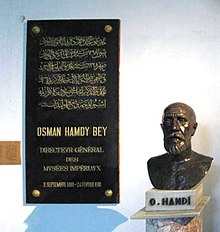Osman Hamdi Bey
[5] He was adopted by Kaptan-ı Derya (Grand Admiral) Hüsrev Pasha[6] and eventually rose to the ranks of the ruling class of the Ottoman Empire.
However, he decided to pursue his interest in painting instead, left the Law program, and trained under French orientalist painters Jean-Léon Gérôme and Gustave Boulanger.
[8] During his nine-year stay in Paris, the international capital of fine arts at the time, he showed a keen interest for the artistic events of his day.
[16] In 1884, he oversaw the promulgation of a Regulation prohibiting historical artifacts from being smuggled abroad (Asar-ı Atîka Nizamnamesi), a giant step in constituting a legal framework of preservation of the antiquities.
His digs included sites as varied as the Commagene tomb-sanctuary in Nemrut Dağı in southeastern Anatolia[17] (a top tourist's venue in Turkey and a UNESCO World Heritage Site today, within the Adıyaman Province), the Hekate sanctuary in Lagina in southwestern Anatolia (much less visited, and within the Muğla Province today), and Sidon in Lebanon.
[19] The painting expresses a sarcastic innuendo on the painter's own view of his style of work compared to those of his collaborators and apprentices, and is also a reference to the historical fact of tortoises having been employed for illuminating and decorative purposes, by placing candles on the shell, in evening outings during the Tulip Era in the early 18th century.
[21] Historian Edhem Eldem has identified the source of the painting as an engraving of a Korean circus entertainer printed in Le Tour du Monde (1869), a popular French travel magazine.
Osman Hamdi was a prolific painter and author, whose work dealt with themes of archaeology, travel and folk customs in the Middle East.
Despite being trained by Gérôme and Boulanger, and his reproduction of European orientalist motifs, Hamdi's paintings present Ottoman subjects differently than his contemporaries' works, most notably giving them more active and intellectual roles.
These paintings can be found in private collections and in museums in Vienna, Paris, Liverpool, New York, Berlin and Constantinople (at the Palace of Dolma Bagdsche, at the home of Crown Prince Abdulmejid).
His painting Reading the Coran has been exhibited at "XI BIENNALE INTERNATIONALE DES ANTIQUAIRES" in Paris in 1982 and at the "FINE ART OF THE NETHERLANDS" at the Waldorf-Astoria in New York in November 1982.




